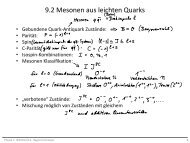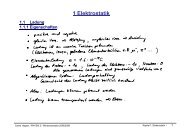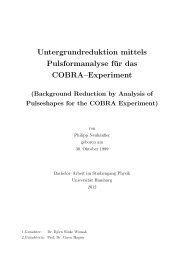Setup of a Drift Tube Muon Tracker and Calibration of Muon ...
Setup of a Drift Tube Muon Tracker and Calibration of Muon ...
Setup of a Drift Tube Muon Tracker and Calibration of Muon ...
You also want an ePaper? Increase the reach of your titles
YUMPU automatically turns print PDFs into web optimized ePapers that Google loves.
However, it did not yet deliver an answer to the solar neutrino puzzle but ratherconfirmed the lower than expected ν e flux.With the experimental observation <strong>of</strong> neutrino oscillations (cf. Section 2.2) in1998 by the Super-Kamiok<strong>and</strong>e experiment [12] <strong>and</strong> the confirmation for solar neutrinosin particular by the SNO experiment in 2001 [13], the solar neutrino puzzlecould finally be resolved. The latter experiment succeeded in measuring both thesolar ν e flux in CC reactions as well as the fluxes from all neutrino types through NCprocesses. Whereas the ν e flux was again only about one third <strong>of</strong> the expected, thetotal flux was in agreement with the predictions. The answer to the solar neutrinopuzzle was found: some <strong>of</strong> the originally electron type neutrinos change their flavoron the way from the Sun to Earth <strong>and</strong> are thus not detected by experiments mereleysensitive to ν e .The evidence <strong>of</strong> neutrino oscillations also showed that neutrinos have a non vanishingmass after all. However, it does not give an answer to the absolute neutrinosmasses—only the squared mass splittings can be determined, leaving also the question<strong>of</strong> the mass hierarchy mostly unanswered. The determination <strong>of</strong> the absolute(electron type) neutrino mass has been addressed by several experiments, e.g. byinvestigating the endpoint energy <strong>of</strong> the β decay <strong>of</strong> tritium. Both the Mainz [14] <strong>and</strong>the Troitsk [15] experiments found an upper limit slightly above 2eV. Currently, theKATRIN [16] experiment is being built aiming at a sensitivity <strong>of</strong> 0.2 eV.Neutrinos are the only leptons with no charge. This leaves the possibility for theneutrino to be its own anti particle. This scenario was first suggested by E. Majoranain 1937 [17] <strong>and</strong> such a neutrino would be called a Majorana particle. If neutrinos aredifferent from their anti particles they are called Dirac particles. The assumption <strong>of</strong>neutrinos being their own anti particles leads to some interesting consequences likethe neutrinoless double-beta decay (0νββ). In an ordinary (two neutrino) doublebetadecay, two electrons <strong>and</strong> two neutrinos are emitted. If the neutrino is indeed aMajorana particle, the two neutrinos could annihilate, thus only two electrons wouldbe emitted. Several experiments now search for the neutrinoless double-beta decay(e.g. [18–20]).2.2 Neutrino Mixing <strong>and</strong> OscillationsNeutrino oscillations have been experimentally verified by various experiments duringthe last decade. The existence <strong>of</strong> neutrino oscillations pro<strong>of</strong>s that neutrinos havea mass, after all. Also, lepton number conservation within each lepton generation isbroken. This section gives a short introduction to neutrino oscillations. First, thegeneral case in vacuum is considered. It is followed by a look at the influence <strong>of</strong>matter to neutrino oscillations.2.2.1 Oscillations in VacuumIn case <strong>of</strong> a non vanishing neutrino mass, the neutrino’s mass eigenstates |ν i 〉 donot necessarily have to be the same as the weak eigenstates |ν α 〉. A neutrino |ν α 〉 <strong>of</strong>flavor α, where α = e,µ or τ can then be described by a superposition <strong>of</strong> the mass7





